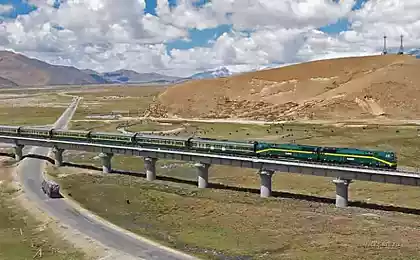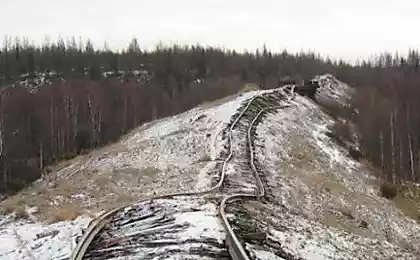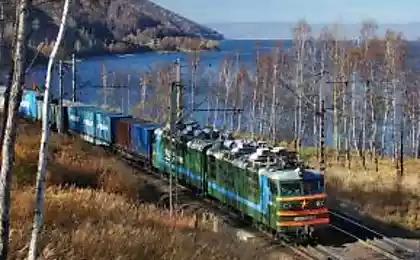1396
Qinghai-Tibet Railway - the road to the roof of the world (31 photos)
Qinghai-Tibet Railway - the most high-mountain railway in the world. "The road to the roof of the world» - Train to the roof of the world. Connect the administrative center of Tibet - Lhasa via Golmud and Xining with the rest of the railway network of the country.

Railway in Tibet was planned long ago. As early as 1958, Mao Zedong instructed to consider stroitestva railway in Tibetstky Autonomous Region, despite the fact that the experience of building railways in such, without exaggeration, the extreme conditions then there was none.

Work on the first phase of construction of the Qinghai-Tibet Railway began in 1960. By 1962, it has been fully developed and approved documentation. Construction was carried out by the prisoners - thus performed the task as much as possible to reduce costs. In 1979 he came to Golmud railway track. Construction of the road next to the mountains, though it was approved, but health complications prisoners builders associated with oxygen deprivation, as well as the fact that a significant part of the road will be laid in a commonplace to frost, forced to stop construction.
In the early years, the site Xining - Golmud is exclusive used by the military, and only in 1984, it opened to passenger traffic. At the construction of the railway to the Tibetan capital stopped for more than 10 years ...
In the second half of the 90s, the government gave the order to adjust the projected track line, as well as new research in terms of the economic feasibility of its construction. The result of this was the fact that in February 2001, the Chinese Ministry of Construction has approved the continuation of the construction of highway, announcing its completion one of the state prioretety.
July 29, 2001 of the two ends of Lhasa and Golmud of units builders have moved toward each other. At the same time, the site of the first stage, Xining - Golmud undergone serious modernization: the overhaul was carried out some engineering structures, updated system, which significantly increase the capacity of the site.

October 15, 2005, the construction of a railway trans road was completed. Despite the fact that this event is very widely covered in the press, including in the world, for Tibet it did not mean the presence of a direct connection by rail with the rest of the world: the builders requested a few more months for running and debugging of the line. This went on for another 15 months.
Finally, July 1, 2006 opened a regular passenger traffic in the entire Qinghai-Tibet Railway. All the way from Beijing to Lhasa takes 48 hours.

From a technical point of view, the construction of the second stage of the road was extremely difficult. 80% of the road is at an altitude of more than 4000 meters above sea level, among them, 160 kilometers at altitudes of 4,000 - 4,500 meters, 780 kilometers at altitudes of 4500 - 5000 meters and 20 kilometers of the line passes at an altitude of 5000 meters.
The highest railway station - Tangula pass. It is located at an altitude of 5068 meters above sea level. This - the highest situated railway station in the world. Not far from her train pass the highest point of the route - 5072 meters.
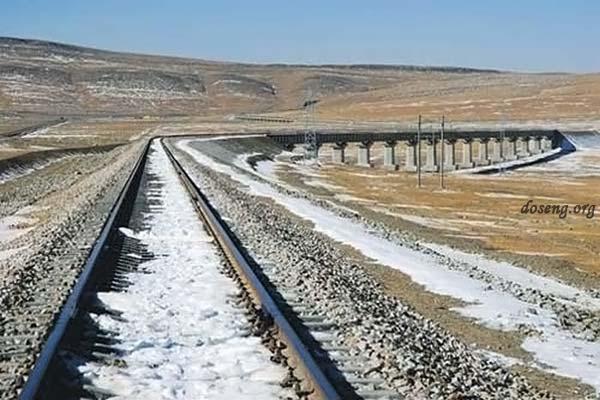

Near the station does not have any town or village. Trains stop here infrequently, while coaches are always closed - go to the platform passengers are not allowed: because at that altitude the percentage of oxygen in the air sostavlet from 60% to 40% compared to sea level. When held the opening ceremony of highway, many journalists needed medical aid. Medinitsnskie workers accompany passenger trains today.
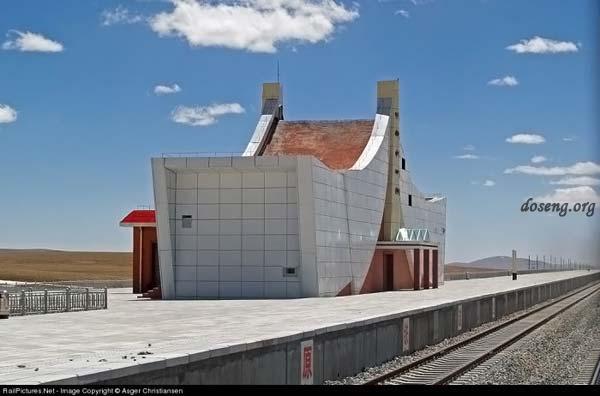
Another serious problem faced by the builders of MDM was permafrost. In such circumstances, located 640 kilometers line. At the same time, it is worth noting that the permafrost in Tibet is very special, alpine. It has some differences from the familiar to us as the permafrost in northern latitudes. However, to solve the problems encountered during construction, we were invited Russian engineers, because our country has a lot of experience in the construction of railroads in similar geological conditions, especially during the construction of the Baikal-Amur Mainline. Handy and experience of our engineers during tunnel construction. On the Qinghai-Tibet Railway is the highest mountain tunnel in the world, at an altitude of 4905 meters, and the longest tunnel - more than 3,300 meters at an altitude of 4264 meters in 80 kilometers from the destination - Lhasa.

Often in these places come and storms. In some cases, the wind speed can be up to 150 kilometers per hour. Half raspozhena line in a seismic zone: here there are earthquake, force 8 or more points.
Technical characteristics: length of 1142 kilometers, 965 kimetrov at an altitude of 4000 meters, the maximum slope 20,000th, the minimum curve radii of 600 meters, vertical - 800 meters. Rasschёtnaya travel speed of 100 kilometers per hour. 7 tunnels and 675 bridges, total length of nearly 160 kilometers. Single-line with the road, neelektrofitsirovannaya. But at the same time, made possible by electrification backlogs line in the future, as well as for increased speed.

A separate line of the project was ecology. A significant part of the bridges located on a line made for the smooth passage of animals beneath them. The same technology used and soundproofing.

Passenger cars have been specially developed by the company "Bombardier" commissioned by the Chinese railways. Wagons full germitichny, designed for speed of up to 120 km / h. The three classes of cars: sedentary, reserved seats and suites. The inscriptions are duplicated everywhere in Tibetan, Chinese and English. Under each passenger is subject of a connector for oxygen tube and control panel oxygen. With the sudden razgermitizatsii automatically recline the individual oxygen masks. Diesel locomotives for the line in Pennsylvania produced in factories of the concern General Electric.



Dining car.


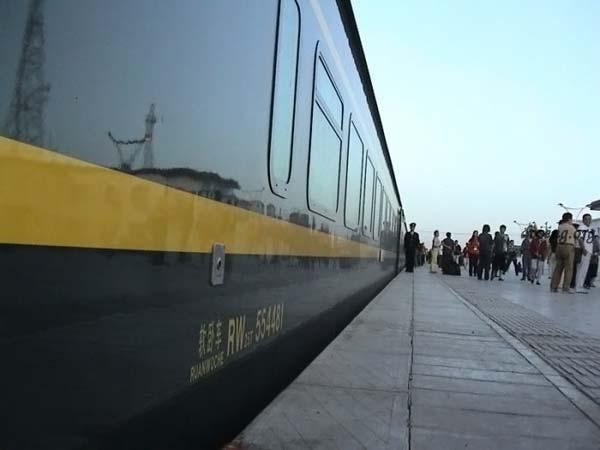
Total car.








Station Station Xining.

Station Station Golmud.

Endpoint line - the station of Lhasa.

Station platform station of Lhasa.

Station platform station of Lhasa.




Railway in Tibet was planned long ago. As early as 1958, Mao Zedong instructed to consider stroitestva railway in Tibetstky Autonomous Region, despite the fact that the experience of building railways in such, without exaggeration, the extreme conditions then there was none.

Work on the first phase of construction of the Qinghai-Tibet Railway began in 1960. By 1962, it has been fully developed and approved documentation. Construction was carried out by the prisoners - thus performed the task as much as possible to reduce costs. In 1979 he came to Golmud railway track. Construction of the road next to the mountains, though it was approved, but health complications prisoners builders associated with oxygen deprivation, as well as the fact that a significant part of the road will be laid in a commonplace to frost, forced to stop construction.
In the early years, the site Xining - Golmud is exclusive used by the military, and only in 1984, it opened to passenger traffic. At the construction of the railway to the Tibetan capital stopped for more than 10 years ...
In the second half of the 90s, the government gave the order to adjust the projected track line, as well as new research in terms of the economic feasibility of its construction. The result of this was the fact that in February 2001, the Chinese Ministry of Construction has approved the continuation of the construction of highway, announcing its completion one of the state prioretety.
July 29, 2001 of the two ends of Lhasa and Golmud of units builders have moved toward each other. At the same time, the site of the first stage, Xining - Golmud undergone serious modernization: the overhaul was carried out some engineering structures, updated system, which significantly increase the capacity of the site.

October 15, 2005, the construction of a railway trans road was completed. Despite the fact that this event is very widely covered in the press, including in the world, for Tibet it did not mean the presence of a direct connection by rail with the rest of the world: the builders requested a few more months for running and debugging of the line. This went on for another 15 months.
Finally, July 1, 2006 opened a regular passenger traffic in the entire Qinghai-Tibet Railway. All the way from Beijing to Lhasa takes 48 hours.

From a technical point of view, the construction of the second stage of the road was extremely difficult. 80% of the road is at an altitude of more than 4000 meters above sea level, among them, 160 kilometers at altitudes of 4,000 - 4,500 meters, 780 kilometers at altitudes of 4500 - 5000 meters and 20 kilometers of the line passes at an altitude of 5000 meters.
The highest railway station - Tangula pass. It is located at an altitude of 5068 meters above sea level. This - the highest situated railway station in the world. Not far from her train pass the highest point of the route - 5072 meters.


Near the station does not have any town or village. Trains stop here infrequently, while coaches are always closed - go to the platform passengers are not allowed: because at that altitude the percentage of oxygen in the air sostavlet from 60% to 40% compared to sea level. When held the opening ceremony of highway, many journalists needed medical aid. Medinitsnskie workers accompany passenger trains today.

Another serious problem faced by the builders of MDM was permafrost. In such circumstances, located 640 kilometers line. At the same time, it is worth noting that the permafrost in Tibet is very special, alpine. It has some differences from the familiar to us as the permafrost in northern latitudes. However, to solve the problems encountered during construction, we were invited Russian engineers, because our country has a lot of experience in the construction of railroads in similar geological conditions, especially during the construction of the Baikal-Amur Mainline. Handy and experience of our engineers during tunnel construction. On the Qinghai-Tibet Railway is the highest mountain tunnel in the world, at an altitude of 4905 meters, and the longest tunnel - more than 3,300 meters at an altitude of 4264 meters in 80 kilometers from the destination - Lhasa.

Often in these places come and storms. In some cases, the wind speed can be up to 150 kilometers per hour. Half raspozhena line in a seismic zone: here there are earthquake, force 8 or more points.
Technical characteristics: length of 1142 kilometers, 965 kimetrov at an altitude of 4000 meters, the maximum slope 20,000th, the minimum curve radii of 600 meters, vertical - 800 meters. Rasschёtnaya travel speed of 100 kilometers per hour. 7 tunnels and 675 bridges, total length of nearly 160 kilometers. Single-line with the road, neelektrofitsirovannaya. But at the same time, made possible by electrification backlogs line in the future, as well as for increased speed.

A separate line of the project was ecology. A significant part of the bridges located on a line made for the smooth passage of animals beneath them. The same technology used and soundproofing.

Passenger cars have been specially developed by the company "Bombardier" commissioned by the Chinese railways. Wagons full germitichny, designed for speed of up to 120 km / h. The three classes of cars: sedentary, reserved seats and suites. The inscriptions are duplicated everywhere in Tibetan, Chinese and English. Under each passenger is subject of a connector for oxygen tube and control panel oxygen. With the sudden razgermitizatsii automatically recline the individual oxygen masks. Diesel locomotives for the line in Pennsylvania produced in factories of the concern General Electric.



Dining car.



Total car.








Station Station Xining.

Station Station Golmud.

Endpoint line - the station of Lhasa.

Station platform station of Lhasa.

Station platform station of Lhasa.









